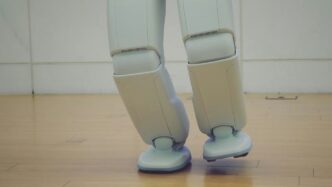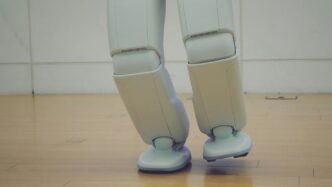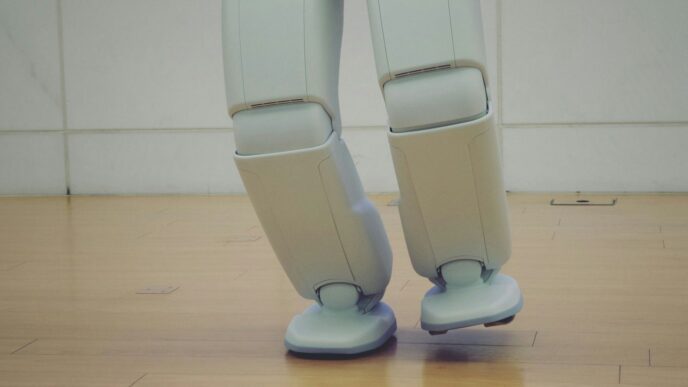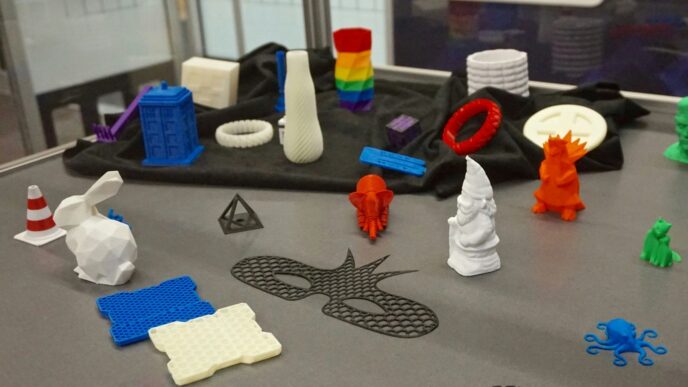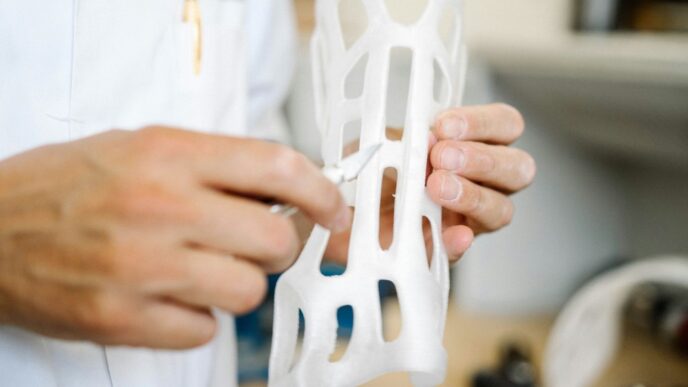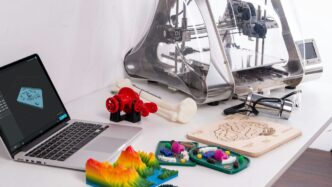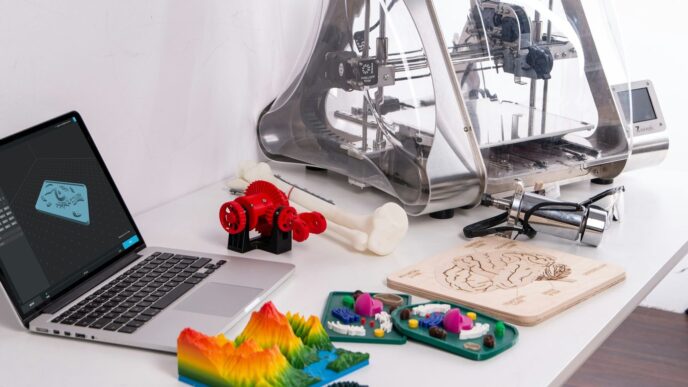The Evolution Of Automated Production
It’s pretty wild to think about how much manufacturing has changed, right? We’ve gone from people doing everything by hand, which must have taken forever and been super tiring, to these incredibly complex automated systems we see today. This whole journey really kicked off with basic mechanization. Think early assembly lines and simple machines that could do one specific job over and over. It wasn’t AI or anything, but it was a huge step up from just manual labor.
From Manual Labor to Mechanized Processes
Back in the day, making anything meant a lot of hands-on work. Skilled craftspeople would spend hours, sometimes days, on a single item. Then came the industrial revolution, and suddenly, machines could do a lot of the heavy lifting. Conveyor belts started showing up, moving parts from one station to another without a person having to carry them. This meant factories could make more stuff, faster. It wasn’t about making things perfect, but about making a lot of them. This shift cut down on how much physical effort was needed and started to lower the cost of goods, making them more accessible to more people. It was the beginning of mass production, really.
Key Milestones in Automation History
There have been some really big moments that changed the game. The invention of the programmable logic controller, or PLC, in the 1960s was a game-changer. It allowed machines to follow a set of instructions, making them more reliable and repeatable. Then, in the 1980s, industrial robots started becoming more common. These weren’t the fancy, human-like robots you see in movies, but sturdy machines designed to do specific, often dangerous or repetitive, tasks on the assembly line. More recently, we’ve seen the integration of AI and the Internet of Things (IoT). This allows machines to ‘talk’ to each other and to us, sharing data in real-time. This means we can monitor what’s happening, fix problems before they even start, and adjust production on the fly. It’s a far cry from just a conveyor belt!
The Core Technologies Powering Automated Production
So, what actually makes all this automation work? It’s a mix of things. First, there are the robots themselves – industrial arms that can weld, paint, or assemble parts with incredible speed and accuracy. Then, you have sensors everywhere, constantly collecting data about temperature, pressure, position, and more. This data is fed into control systems, often powered by sophisticated software. Think of it like the ‘brain’ of the operation. Increasingly, artificial intelligence and machine learning are being used to analyze all this data. They can predict when a machine might break down, optimize the flow of materials, or even adjust production parameters to improve quality. It’s this combination of hardware, software, and smart algorithms that allows modern factories to run so efficiently.
Robotics And Intelligent Machinery
Robotics and Industrial Automation
Robots are no longer just science fiction; they’re a huge part of factories today. Think about tasks like welding car parts, putting together electronics, or just moving materials around the plant floor. Industrial robots are doing a lot of this now. They’re getting smarter and more flexible, too. Some can even work right alongside people, which is pretty wild when you think about it. The numbers back this up: the world had about 3.5 million industrial robots in operation by 2022, a jump from the year before. Companies like Tesla are using tons of robots in their factories to build electric cars faster and with more accuracy. Even places like BMW are using what they call ‘cobots’ – collaborative robots – to help human workers with repetitive jobs. This cuts down on physical strain and just makes things run smoother overall.
The Role of Artificial Intelligence and Machine Learning
Artificial Intelligence (AI) and Machine Learning (ML) are really what make these automated systems so smart. They let machines learn from all the data they collect, predict what might happen, and tweak processes on the fly. ML algorithms can sift through huge amounts of information to spot patterns, find oddities, and make adjustments in real-time. This means better efficiency and higher quality. For instance, General Electric uses AI to predict when machines might break down. This saves them a ton of money and keeps their equipment running longer. Some reports suggest this kind of predictive maintenance can cut machine downtime by half and lower repair costs significantly. Amazon also uses AI in its warehouses to manage inventory and speed up order processing, which helps get products to us faster.
Designing Modern Automated Production Lines
Creating these modern automated production lines involves a few key steps. It’s not just about plugging in a robot and hoping for the best. You have to think about how everything will connect and work together. Here’s a general idea of how it often goes:
- Process Analysis: First, you really need to look at what you’re making and how you’re making it now. What are the bottlenecks? Where are the errors happening? What tasks are repetitive or dangerous for humans?
- Technology Selection: Based on that analysis, you pick the right tools. This could be specific types of robots (like articulated arms, SCARA robots, or collaborative robots), automated guided vehicles (AGVs) for moving things, advanced sensors for quality checks, and the software to control it all.
- System Integration: This is where it all comes together. You have to make sure the robots, machines, sensors, and software can all talk to each other. This often involves complex programming and network setup.
- Testing and Optimization: Once it’s built, you test everything thoroughly. You run simulations, then real production runs, and make adjustments to fine-tune performance, speed, and accuracy. The goal is a smooth, efficient flow from raw materials to finished product.
- Human-Machine Collaboration: Designing these lines also means figuring out the best way for people and machines to work together safely and effectively. This might involve safety zones, user-friendly interfaces for monitoring, and training for the human operators.
Enhancing Product Quality And Consistency
When you automate production, things just get better and more predictable. Think about it: instead of relying on someone’s good day or steady hand, you’ve got machines doing the work. These machines, guided by sensors and smart software, don’t get tired or distracted. This means every single item that comes off the line is pretty much identical to the last one.
Benefits of Automated Production for U.S. Industries
Automated systems really help American businesses. They can crank out more stuff, faster, and with fewer mistakes. This isn’t just about making more widgets; it’s about making them right, every time. Plus, when you cut down on the need for manual labor for repetitive tasks, you can shift your workforce to more complex jobs. It’s a win-win.
- Reduced Human Error: Machines follow instructions precisely, cutting down on mistakes that can happen with manual assembly or inspection.
- Increased Throughput: Automated lines can operate continuously, leading to higher production volumes.
- Cost Savings: While the initial investment can be high, long-term savings come from reduced labor costs, less material waste, and fewer product recalls.
Boosting Efficiency and Productivity
This is where automation really shines. Machines can work around the clock without needing breaks. They can perform tasks much faster than humans, and they do it consistently. This jump in speed and reliability means you can get a lot more done in the same amount of time. It’s like going from a bicycle to a sports car for your factory floor.
Achieving Greater Precision and Reduced Errors
Precision is the name of the game here. Automated systems use sensors and feedback loops to make sure every step is just right. If a part is slightly out of place, the system can detect it and correct it, or flag it for review. This level of detail means fewer defects and a much more reliable final product. The consistency achieved through automation is a major reason why companies are adopting these technologies.
| Metric | Manual Production (Estimate) | Automated Production (Estimate) |
|---|---|---|
| Defect Rate | 5-10% | 0.5-2% |
| Production Speed | 100 units/hour | 500+ units/hour |
| Consistency Score | Moderate | Very High |
Key Technologies Driving Automated Production
So, what’s actually making all this automation happen? It’s not just one magic bullet, but a mix of smart tech working together. Think of it like a well-oiled machine, where each part plays its role.
Integration of AI and Digital Tools
Artificial intelligence (AI) and machine learning (ML) are pretty big deals here. They’re like the brains behind the operation. These systems can look at tons of data from the factory floor – think sensor readings, production speeds, quality checks – and find patterns we might miss. This ability to learn and adapt is what lets automated systems get better over time. For example, AI can predict when a machine might break down, so you can fix it before it causes a major stoppage. Digital tools, like advanced simulation software, also help design and test production lines before they’re even built, saving a lot of headaches and money.
Advances in Automation Engineering
Engineers are constantly coming up with new ways to make automation work better. We’re seeing more flexible robots that can do different jobs without needing a complete overhaul. Think about robots that can work safely alongside people, called cobots. They help with repetitive or heavy tasks, making the human workers’ jobs easier and safer. Plus, the sensors and control systems are getting way more precise. This means fewer mistakes and a more consistent product, every single time. It’s all about making these systems smarter, more adaptable, and easier to manage.
The Concept of Software-Defined Factories
This is a newer idea, but it’s changing things fast. Instead of a factory being defined by its physical machines, a software-defined factory is controlled and managed mostly through software. This makes it super flexible. You can change what the factory makes or how it makes it just by updating the software, not by moving heavy equipment around. It’s like having a digital blueprint that can be changed on the fly. This approach helps companies respond quickly to what customers want or what the market is doing. It also makes it easier to connect different parts of the production process and get real-time information about everything that’s happening.
Challenges And Considerations In Adopting Automation
So, you’re thinking about bringing more automation into your factory? That’s a big step, and honestly, it’s not always a walk in the park. There are definitely some hurdles to clear before you can just flip the switch and expect everything to run itself.
Effective Management of Costs and Risks
First off, let’s talk money. Automation isn’t cheap. You’ve got the upfront cost of the machines, the software, and getting it all set up. Figuring out the total investment and how long it’ll take to see your money back is key. It’s not just about buying the gear; you also need to think about potential problems. What if a new system goes down? What if it doesn’t work as well as you hoped? You need a plan for these ‘what ifs’ to avoid big headaches and unexpected expenses. It’s like planning a big road trip – you budget for gas, food, and maybe a hotel, but you also stash away a little extra for flat tires or detours.
Ensuring Optimal Use of Production Capacity
Once you’ve got your shiny new automated systems, you need to make sure they’re actually working hard. It’s easy to overspend on tech and then not use it to its full potential. Think about it: if you buy a super-fast race car but only drive it around your neighborhood, you’re not getting your money’s worth, right? The same goes for automation. You need to make sure your production lines are running smoothly, producing what you need, when you need it. This means:
- Scheduling production runs efficiently: Don’t leave machines idle if there’s work to be done.
- Monitoring performance in real-time: Keep an eye on output and identify bottlenecks quickly.
- Planning for maintenance: Regular check-ups keep things running and prevent costly breakdowns.
Preparing for Workforce Adaptation
This is a big one, and it’s often overlooked. Automation changes jobs. Some tasks that people used to do might disappear, but new jobs will pop up. These new roles often require different skills – maybe operating complex machinery, fixing robots, or managing the software. So, you can’t just bring in robots and expect everyone to know what to do. You’ve got to invest in your people. This means:
- Training programs: Help your current employees learn the new skills needed.
- Clear communication: Talk to your team about the changes and why they’re happening.
- Support for transitions: Help workers move into new roles where possible.
It’s about making sure your team feels secure and ready for the future, not left behind. Plus, a well-trained team is way better at spotting issues and making the automation work its best.
Real-World Impact Of Automated Production
It’s pretty wild to see how automation is changing things in the real world, not just in theory. We’re talking about actual factories running with way fewer people on the floor, making stuff faster and, honestly, better.
Tesla’s Manufacturing Revolution
Take Tesla, for example. At their Gigafactory in Shanghai, they’ve managed to automate about 95% of the production process. This means they can build a Model Y in something like 10 hours. Compare that to traditional car makers that might take 30 hours, and you see a huge difference. They’re using over 200 robots in some of these places, plus smart carts that move parts around. This setup has apparently boosted their efficiency by up to 50% in some cases. It’s a big deal when you can crank out thousands of cars a week with that kind of speed.
Manufacturing ROI Success
Companies that are really jumping into advanced automation are seeing some solid returns. A study by Boston Consulting Group found that these businesses are getting about a 16% bump in how much they can produce and a 12% cut in their operating costs. It’s not just for big, fancy car companies either. Even the food and beverage industry is adopting automation more and more, with growth rates around 8.5% annually. Sometimes, just updating older systems can save around 50% compared to how things were done before. This shows that automation isn’t just a futuristic idea; it’s a practical way to save money and make more.
Grid Modernization Impact
While not strictly manufacturing, the impact of automation extends to how we manage energy, which is pretty important for factories. Companies like Shell are using AI to predict when equipment might fail, which helps them cut down on maintenance costs. They’re saving billions each year because of this. On a larger scale, countries are investing heavily in smart grid technology. Think billions of dollars being put into making our energy systems more automated and efficient. This kind of modernization means more reliable power for everyone, including the factories that need it to run their automated lines.
The Road Ahead
So, looking back, it’s pretty clear that automated production isn’t just a passing trend. It’s really changed how we make things, from the factory floor all the way up. We’ve seen how machines and smart tech can speed things up, make stuff better, and help companies keep up with what everyone wants. It’s not always a smooth ride, though. Figuring out the costs and making sure people can work with these new tools are big parts of the puzzle. But as we keep moving forward, these changes are definitely going to shape what manufacturing looks like for a long time to come.



